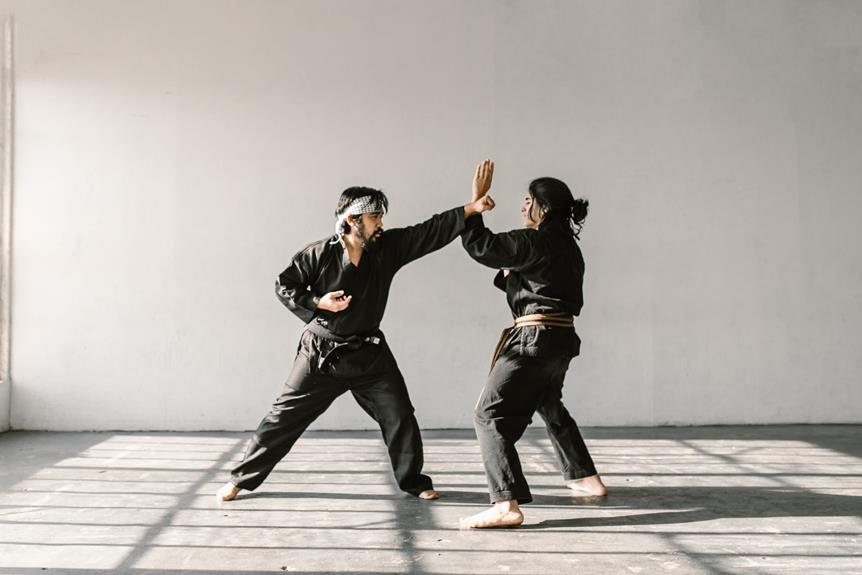Mixed martial arts (MMA) is a captivating world where discipline and skill collide. However, when it comes to the presence of a universally adopted belt system, the answer is not as clear-cut.
Unlike traditional martial arts, MMA lacks a standardized ranking belt system recognized across the board. This can be attributed to the sport's youth and the diversity of disciplines it encompasses.
Nevertheless, efforts are underway to introduce a belt system, such as the one by the International Mixed Martial Arts Federation (IMMAF).
In this article, we will delve into the various belt systems in MMA, their significance, and the ongoing debate surrounding their adoption and role in the sport's development.
Key Takeaways
- There is no universally adopted belt system in MMA.
- The IMMAF has introduced its own belt system for MMA schools, but it is not widely adopted.
- Belts in MMA do not indicate fighting ability and are not used during fights.
- The focus in MMA is on competition, entertainment, and defeating opponents, rather than on belt rankings.
Lack of Universally Adopted Belt System
The lack of a universally adopted belt system in MMA is a result of the sport's relatively short history and its incorporation of various martial arts with their own distinct ranking systems. This lack of standardization has had a significant impact on the MMA community. Without a universally recognized belt system, it becomes difficult to assess a fighter's skill and experience, leading to confusion and inconsistency in determining rankings and matchups.
To address this issue, the International Mixed Martial Arts Federation (IMMAF) has taken steps to promote amateur MMA through its own belt system. Introduced for MMA schools, the IMMAF belt system helps keep students invested in the sport by providing a clear pathway for progression. However, it is important to note that the IMMAF belts do not indicate fighting ability, but rather demonstrate technical progression and commitment to the sport.
While the IMMAF belt system has gained recognition, it is unclear how widespread its adoption will become. Nonetheless, IMMAF's efforts in promoting amateur MMA and providing a standardized belt system contribute to the growth and development of the sport overall.
IMMAF MMA Belt System
Introduced by the International Mixed Martial Arts Federation (IMMAF) for MMA schools, the IMMAF MMA belt system provides a standardized pathway for progression and serves to keep students invested in the sport.
While belts in MMA do not indicate fighting ability, the IMMAF MMA belt system offers a structured framework for students to track their technical growth and development. The belt progression in the IMMAF system starts with yellow and advances through orange, green, blue, purple, brown, and finally black belt.
In order to advance to the next belt, students must spend a minimum of one year with their current belt and demonstrate technical progression. The adoption of the IMMAF MMA belt system is also required for competing at the IMMAF Youth MMA World Championships.
Belt Order and Requirements
To understand the belt order and requirements in MMA, one must consider the various systems implemented by different martial arts schools and organizations.
The belt system in MMA serves multiple purposes, one of which is to motivate and incentivize students to continue their training. By offering different colored belts as a symbol of progress and achievement, students are encouraged to work harder and strive for higher levels of mastery.
Additionally, the belt system also serves as a marketing tool for martial arts schools, attracting potential students by showcasing their structured and progressive training programs.
However, it is important to note that the belt system in MMA does not directly correlate with fighting ability. It is a representation of technical progression and dedication to the art, rather than a measure of one's skills in the cage.
Adoption and Recognition of IMMAF Belt System
IMMAF's belt system for MMA has gained varying levels of adoption and recognition within the martial arts community. While some schools have embraced the system, others have chosen to stick with their own belt systems or not use belts at all. However, the IMMAF belt system does offer several advantages for those who choose to implement it.
Advantages of IMMAF Belt System:
- Provides a structured progression for students, keeping them invested in the sport.
- Offers a clear path for advancement, with specific requirements for each belt level.
- Helps standardize the training and skill development process across different schools.
- Creates a sense of community and belonging among practitioners, fostering camaraderie and support.
Implementing the IMMAF belt system also comes with its challenges. Some schools may be resistant to change or prefer to maintain their own systems. Additionally, gaining widespread recognition and adoption for the IMMAF belt system remains uncertain. However, as IMMAF continues to grow and promote amateur MMA, the adoption and recognition of their belt system may become more widespread, further enhancing the development of the sport.
Other MMA Belt Systems
Other MMA schools have also implemented their own belt systems, although these are not widely recognized on a large scale in the sport. These systems are often seen as money-making ventures rather than indicators of skill and progression. However, they can still play a role in motivating and retaining MMA students. Let's take a look at some pros and cons of other MMA belt systems:
| Pros | Cons |
|---|---|
| Provides a sense of achievement and recognition | Lack of standardization and recognition in the wider MMA community |
| Encourages students to set goals and track their progress | Potential for abuse and exploitation by schools |
| Enhances the student's sense of belonging and identity within the school | Belts may not accurately reflect the student's actual fighting ability |
| Can serve as a marketing tool to attract new students | Focus on belts may overshadow the importance of actual training and skill development |
While other MMA belt systems may have their advantages, it is important to approach them with caution and consider the overall goals and values of the sport. The primary focus should always be on training, skill development, and competing at a high level.
Belts Not Used During Fights
During fights in MMA, the use of belts is not implemented. Unlike traditional martial arts, where belts are worn during training and competitions, MMA focuses solely on the combat aspect.
Belts have a significant role in MMA culture, symbolizing progression, skill, and dedication. However, their perception in the MMA community is varied. Some see belts as essential for motivation and recognition, while others believe that they are unnecessary and can be seen as a money-making system.
The absence of belts during fights allows the focus to be on the competition itself, the entertainment value, and the goal of defeating opponents. In MMA, the emphasis is on the skill and technique displayed in the cage, rather than the color of the belt around a fighter's waist.
MMA Focus on Competition and Entertainment
In the realm of MMA, the primary focus is on the intense competition and captivating entertainment, rather than the utilization of belts. While belts have been a traditional symbol of rank and achievement in other martial arts, MMA has taken a different approach. The absence of a universally adopted belt system in MMA is a testament to the sport's unique nature and evolution.
MMA's development and success have been driven by its emphasis on thrilling fights, technical skill, and the ability to defeat opponents, rather than the recognition of belts. This focus on competition and entertainment has allowed MMA to attract a wide audience and establish itself as one of the most exciting combat sports in the world.
Belts may have their place in other martial arts, but in the dynamic world of MMA, the intensity of the fights and the entertainment they provide are the true measures of success.
Conclusion: No Universal Belt System in MMA
The absence of a universally adopted belt system in MMA highlights the sport's unique nature and evolution. While some organizations, like the International Mixed Martial Arts Federation (IMMAF), have introduced their own belt systems for amateur MMA, there is still no standardized ranking system across the entire sport. This lack of uniformity has led to some controversy and debate among MMA fans and practitioners.
Alternatives to belt rankings have emerged in the form of other methods of recognition and progression in the sport. Some MMA schools have developed their own belt systems, although these are not widely recognized on a large scale and are often seen as money-making schemes. Additionally, individual coaches and trainers, such as Greg Jackson, have created their own belt ranking systems, but these have not gained widespread recognition either.
In the end, belts are not used during fights in MMA, as the focus of the sport is on competition, entertainment, and defeating opponents. While the absence of a universal belt system may be a point of contention for some, it is clear that belts are not necessary for the development and success of MMA.
Impact of Belts on MMA's Development and Success
Belts in MMA have had a significant impact on the development and success of the sport. The role of belts in student motivation cannot be overstated.
Belts provide a tangible representation of progress and achievement, giving students a sense of accomplishment and fueling their drive to improve. This motivation is crucial for their development as fighters and for the growth of MMA schools.
The impact of belt systems on MMA schools' profitability is also worth mentioning. Belts create a structured curriculum that allows schools to offer different levels of training and charge higher fees for advanced classes.
Additionally, the prestige associated with higher belts attracts more students, leading to increased enrollment and revenue.
Frequently Asked Questions
How Long Has MMA Been Around and Why Hasn't There Been Standardization in Belt Systems?
The lack of standardization in MMA belt systems can be attributed to the relatively short history of the sport and its diverse martial arts origins. While the IMMAF has introduced a belt system, it is not universally adopted.
What Is the Purpose of the IMMAF MMA Belt System and How Does It Work?
The purpose of the IMMAF MMA belt system is to keep students invested in the sport and to provide a sense of progression. It works by offering different colored belts, with advancement requiring a minimum 1 year with the current belt and demonstration of technical progression.
Are There Any Other Widely Recognized Belt Systems in MMA Apart From the IMMAF System?
There are no widely recognized belt systems in MMA apart from the IMMAF system. Some schools have their own systems, but they lack widespread recognition and are often seen as money-making ventures. In other combat sports, belts are used to indicate rank and skill level.
Why Are Belts Not Used During Fights in Mma?
Belts are not used during fights in MMA primarily because the sport's focus is on competition, entertainment, and defeating opponents. The advantages and disadvantages of using belts in MMA vary and are not directly related to their absence during fights.
What Is the Impact of Having or Not Having a Universally Adopted Belt System on the Development and Success of Mma?
The impact of not having a universally adopted belt system in MMA is that it hinders the sport's development and success. Without standardized belts, it becomes challenging to track and measure progress, potentially discouraging student engagement and hindering the growth of MMA.
Conclusion
In conclusion, the absence of a universally adopted belt system in MMA does not hinder the sport's development or success. MMA's unique nature as a fusion of various martial arts disciplines and its focus on competition and entertainment contribute to the lack of standardization in belt systems.
While efforts are being made to introduce a belt system, such as the one by IMMAF, the significance of belts in MMA lies more in their symbolic value rather than their practical application in fights.
- 15 Best Martial Arts Weapons (Fighting & Training) - October 14, 2024
- Is Fencing a Martial Art? (Yes, 4 Reasons Why) - October 14, 2024
- 7 Best Martial Arts for Self-defense Ranked (Highly Effective) - October 14, 2024










